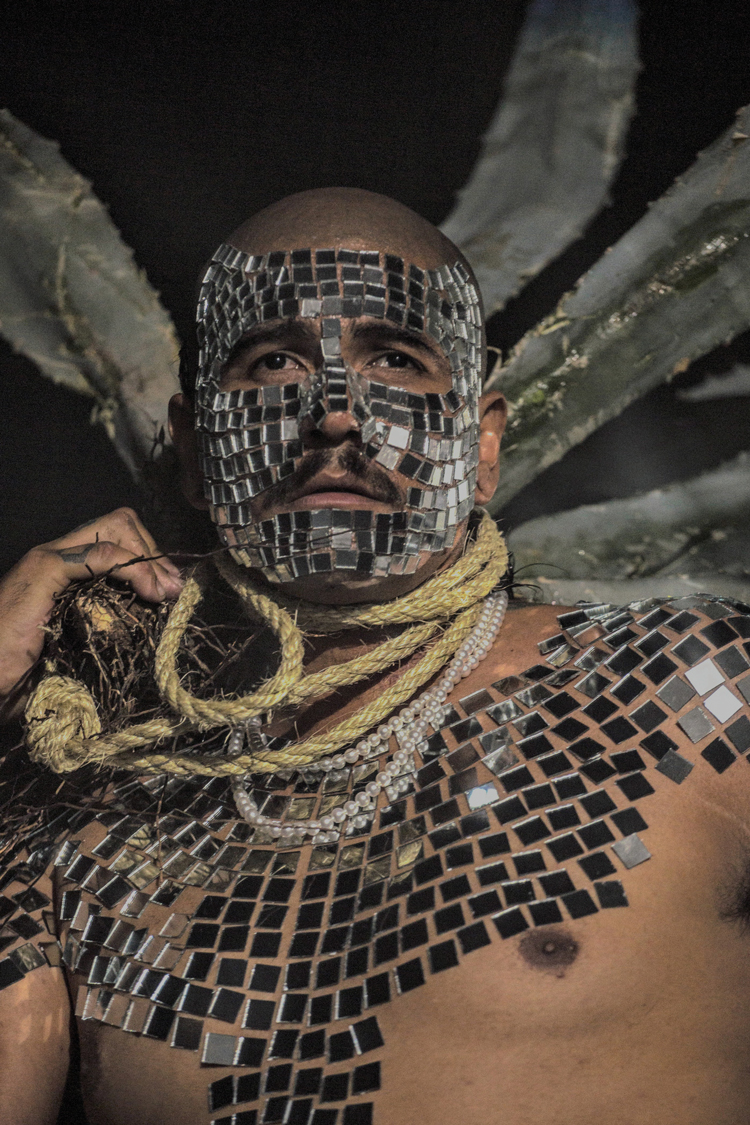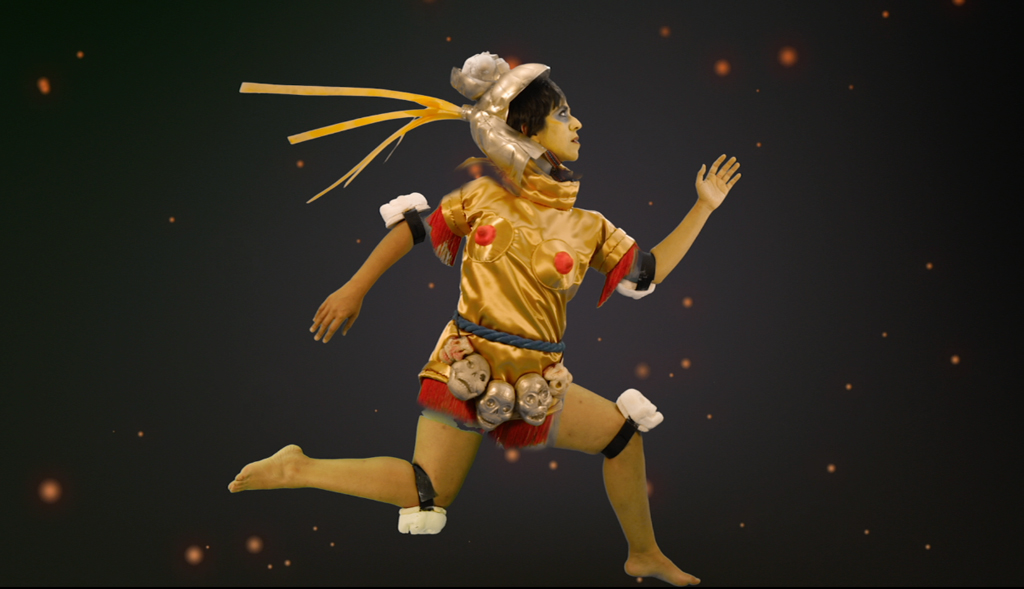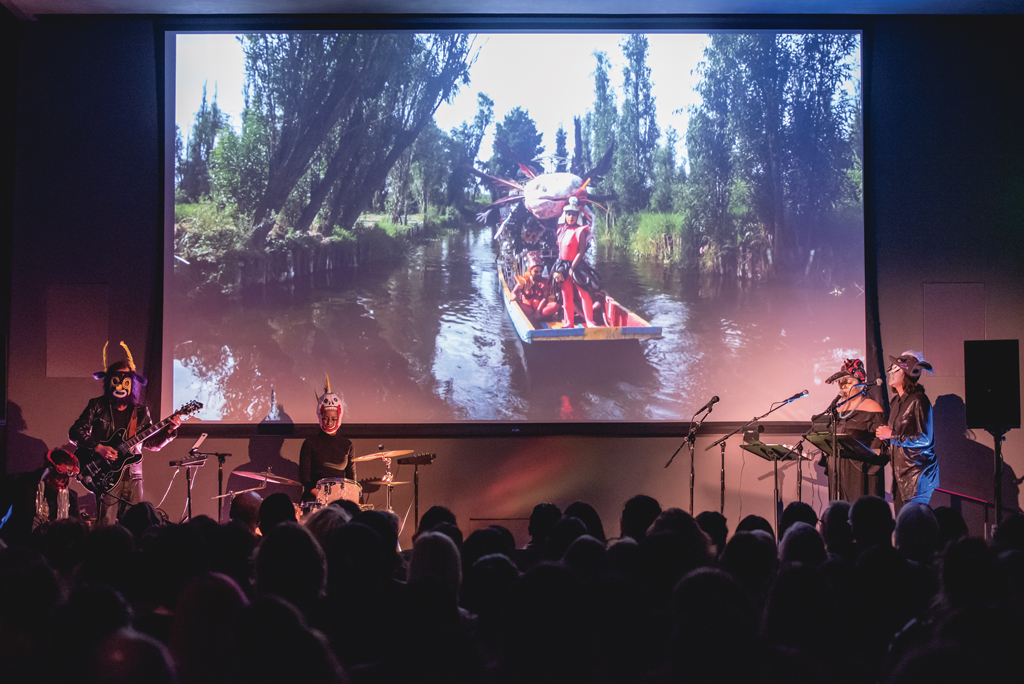[ad_1]

Rafa Esparza, RePartida, con Alejandro, 2017.
COURTESY RED BULL MUSIC ACADEMY
A parade of people marches across a bridge of adobe bricks. Lying underneath is artist Rafa Esparza, who crafted the bricks himself. After a few minutes, Esparza—an important figure in L.A.’s long-lived and still-fertile Latinx performance art scene—emerges, dressed only in white briefs over which he drapes varying shades of red clothing. He climbs onto a wooden platform that spills a cascade of water and walks through the stream. Then he takes position at a podium and begins reading a prose-poem narrative of his family’s migration story and his own personal history in Downtown Los Angeles. “I’m not a bridge, I’m not your bridge, we’re not your bridges,” he says. “We’re water.”
Esparza’s newly commissioned performance at L.A.’s Museum of Contemporary Art, cumbre: look as far as you can see in every direction–north and south, east and west, was one of 75 works staged over 11 days in early 2018 at more than 20 venues as part of the Getty Foundation’s ambitious exhibition initiative Pacific Standard Time: LA/LA. Positioned like all the other enterprising shows in museums and galleries, PST’s “Live Art” series was an attempt to bridge Latinx and Latin American performance art and traverse boundaries within the city to a wider world beyond. “PST: Live is about to change the art landscape in Los Angeles,” an audience member at the Esparza event exclaimed. But one could argue that the change would come not so much from the festival itself as from the legacy it tapped.
“Latinx/Latin American performance art evokes traditions in that there are deep connections to a shared history of economic struggles, colonization, religious persecution, marginalization, indigenous ritual, and contemporary social and political activism,” said Edgar Miramontes, associate director of REDCAT, the multidisciplinary theater and art center that organized PST: Live with more than a dozen different partners. The series proved “a pivotal moment,” he added, “as it provided a platform to highlight and honor the already existing presence of deeply rooted Latinx/Latino performance artists in Los Angeles.”
The lineage traces back to the streets of East L.A. in the 1960s, with a dynamic history connected in part to civil rights activism and political upheaval among Chicano and, by extension, Latino communities over issues related to inequality and matters of race, gender, class, education, and the Vietnam War. In 1968 a series of protests known as the Chicano Blowouts prompted more than 10,000 students in L.A. to stage walkouts in opposition to systemic racism in the city’s public schools. In 1970 a march under the name of the Chicano Moratorium drew some 30,000 anti-war demonstrators for one of the era’s largest protests of Vietnam by people of color. At the same time, the overt machismo associated with Chicano nationalism incited certain performance artists to agitate with work focused on queer and gendering-questioning themes.
Chicano artists in East L.A. had the benefit of working on their own at a time when attention from galleries and other institutions was hard to come by. Famously, a curator at the Los Angeles County Museum of Art told artist Harry Gamboa Jr. in 1971 that Chicanos “are in gangs; they don’t make art.” In the context of performance, their work was free to take on new and different forms, connecting to contemporaneous performance art in other cities and outward through other channels like East L.A.’s teeming punk scene.
Historically, Chicana and Chicano artists have formed bonds through politics and proximity. Today, as we stare down increasing political unrest for Latina and Latino subjects in America, the history of performance art immersed in protest and revolutionary ideology feels more alive than ever in L.A., from murals depicting protests of decades past to community-driven spaces like Highways Performance Space and 18th Street Arts Center that keep the tradition alive.

Naomi Rincón Gallardo, Mundo Zurdo (still), 2018, a video shown as part of the artist’s The Formaldehyde Trip performance.
COURTESY THE ARTIST
Robert Legorreta, aka Cyclona, was one of the first Chicano performance artists to make an impression in L.A. In the mid-’60s, he would don women’s clothing he sewed himself from curtains, put on makeup and false breasts, and walk up and down Whittier Boulevard in East L.A. His performances in what he called “semi-drag”—identifiable as such thanks in part to his beard—often met with harassment and assault. Legorreta transformed such hostilities into the materials of his art.
His first collaborative performance was Caca-Roaches Have No Friends (1969), a dialogue-free play featuring performers in the role of huge lips. After a small first performance in Belvedere Park, the heart of East L.A. for more than 70 years, a larger one followed, thanks to an ad in the Belvedere Citizen calling it a “play for the whole family.” The work’s “Cock Scene” suggested otherwise: In heavy makeup and a black nightgown, Cyclona first undressed himself by rolling down his gown to his waist and then unclothed his stage partner down to a pair of eggs attached to a water balloon tucked into fishnet stockings. Cyclona then broke the eggs with his hands and popped the balloon with his teeth. Families in attendance, mostly from the nearby Estrada Courts Chicano housing community, responded by starting fires in trashcans and running the performers out of the park, as Legorreta recalled.
“I was doing a dangerous thing every time I was performing,” he told me. “I felt I was beyond Chicanoism. I was doing conceptual art.” Now 66 years old, Legorreta lives about 20 miles east of Belvedere Park and has stopped performing. But he remains a crucial figure whose legacy looms. His archival papers are at the UCLA Chicano Studies Resource Center, and the ONE National Gay and Lesbian Archives at the University of Southern California Libraries recently acquired some of his costumes.
“After my performances I would tear the costumes apart and throw them into the audience,” said Legorreta. “I was wild as a child because of my mother. She was a cosmetologist so I was exposed to the beauty salon culture young.” His introduction to drag culture also came from his mother, who told him about doing hair in the ’50s for a customer who called herself Greta, because she looked like Greta Garbo.
In the ’60s, wanting to take his work public so as to change the way people thought about freedom, Legorreta started working with the founding members of the art collective Asco, named for the Spanish word for “disgust” or “nausea.” The group—Harry Gamboa Jr., Patssi Valdez, Willie Herrón III, and Gronk—collaborated with Legorreta in 1969 for Piglick, a piece performed in front of a police station that involved pouring liquid and food on a Volvo and licking it off in what Legorreta called a “food orgy.” The piece protested police brutality and flouted the notion of respectability politics among Mexican Americans.
In the ’70s, Asco organized fashion shows with costumes made from paper and, later, invited Chicana artist Diane Gamboa (sister of Harry) to produce wearable paper fashions. In an interview in 1986, she said these stemmed “from playing with paper dolls as a little girl and always having the fantasy of being glamorous and wearing an original.” Diane was known as a painter and sculptor but for such performances changed her focus to “hit-and-run fashion.”
About two hours north of L.A., in Delano, California, an influential performance group called El Teatro Campesino used art and theater as an organizing tool for members of the United Farm Workers union. Founded in 1965, the troupe was made up of workers who would perform actos in union halls and on flatbed trucks, serving up skits that dramatized the plight of laborers toiling in the fields. Their work was recognized with Los Angeles Drama Critics Circle Awards in 1969 and 1972.
Artist Ray Navarro, a Los Angeles native and AIDS activist in New York with ACT UP (AIDS Coalition to Unleash Power), watched the grassroots performances of El Teatro Campesino and drew inspiration from Asco and other Chicano artists in East L.A. In “Eso, Me Esta Pasando” (or “This Is Happening to Me”), an essay published shortly before his death in 1990, he wrote, “the only Spanish word I knew that described my sexual feelings was a bitter insult: I was a puto.” (Translation: male prostitute.) His work addressed conservativism in the Catholic Church and secular progressivism surrounding AIDS and LGBTQ rights. In DIVA TV’s 1990 documentary Like A Prayer, he can be seen dressed as Jesus imploring into a microphone, “This is Jesus Christ! I’m in front of St. Patrick’s Cathedral on a Sunday. We are here to say, ‘We want to go to heaven too!’ ”
Around the same time, Nao Bustamante, an artist from the San Joaquin Valley whose multimodal work includes performance, video, and writing, presented one of her first solo performances, Indig/urrito (1992), at Highways Performance Space in Santa Monica. Conceived to commemorate the 500th anniversary of the conquest of the Americas, Indig/urrito mixed the term “indigenous” with “burrito” and challenged white men in the audience to express their remorse for colonization by taking bites of a tortilla-wrapped snack that Bustamante had strapped to her body.

Naomi Rincón Gallardo, The Formaldehyde Trip, a live concert and video work pictured here at the Broad, Los Angeles.
COURTESY THE BROAD
Pulling aspects of Chicano performance art’s past into the present, Esparza, who was born in 1981 and raised in L.A., has built on the medium’s contradictions. For another of his pieces presented during PST: Live (along with cumbre), he took to a dance club in the Mayan Theatre, a storied old cinema in Downtown Los Angeles that is stylized with pre-Columbian iconography. Beforehand, Esparza and his collaborator Sebastian Hernández stood at the entrance of the theater on a black platform, separated from the public by a red velvet rope. The duo changed poses every few minutes but never looked directly at anyone entering the space. Esparza’s body was painted neon pink, over which he wore matching pink underwear and a gold chrome neck placard that read “Brown Persuasion.”
For Corpo Ranfla—part of a series of performances grouped under the title Variedades, in tribute to a type of early 20th-century vaudeville show that featured Mexican performers—Esparza took the stage to Kid Frost’s 1990 hip-hop hit “La Raza,” with lyrics boasting “Chicano and I’m brown and I’m proud.” Under blue lights and a large hanging disco ball, Esparza began by posing “low,” crouched down as gang members used to for pictures but also mimicking the appearance of the lowrider cars cruising and—pointedly, politically—slowing traffic on Whittier Boulevard, just as Cyclona had all those decades ago.
As tough as Esparza appeared, elements of femininity (pink body, lace-up heels, jewelry) stared down the masculinity that is inextricably linked with carnalismo (“brotherhood”) in lowrider culture. “This work brilliantly subverted lowrider culture,” Miramontes, from REDCAT, recalled. “The Mayan gave way to queer poses and prancing, to magnificent effect.”
It was a common sight during PST: Live. “Many of the artists,” Miramontes said, “focused on what might traditionally be considered deeply personal issues—especially the body, gender identity, ownership of female bodies, evolving notions of queerness—in a direct and public way that connects the personal to the political.”
Marcus Kuiland-Nazario, the curator of Variedades, said he put the group show together with different Los Angeles performers with the intent to counter the myth that Latinx performance was always rooted in folk forms. His goal was “to show people there is a whole range of expressions that are being created in Los Angeles by Latin American artists and artists of Latin American descent.” Doing so in the form of a variedades show was his “love letter to Los Angeles.”
Elsewhere during PST: Live, Carmina Escobar vocalized birdlike chirps and other sounds while floating in Echo Park Lake as a Oaxacan brass youth band played, in a piece titled Fiesta Perpetua! And Raul Baltazar staged a ritualistic procession through Ascot Hills Park coupled with picnics and performances for generations of cultural workers in Mi Sereno. The title of the piece translates as “My Peace,” but it also alludes to El Sereno, an L.A. neighborhood with a strong Latino presence.
Performance art in L.A. also shares deep connections with artists from Mexico and throughout Latin America, with the histories of home countries woven into the city’s very fabric. A prime example at PST: Live was The Formaldehyde Trip by the Mexico City–based artist Naomi Rincón Gallardo. Curated by artists Nao Bustamante and Xandra Ibarra and shown at the Broad, the work presented songs and videos dedicated to murdered Mixtec activist Alberta “Bety” Cariño that mixed ideas of speculative fiction with a journey into the underworld while asking how we might find a utopian future. In a song near the show’s end, a punk melody accompanied a video of people in animal costumes rolling around to a chorus of “shoulder to shoulder / mud, mud, mud / elbow to elbow / mud, mud, mud / bones to ashes.” The lyrics suggested a process of mutation, change, and rebirth, with mud as the maker of something new between the body parts it covers.
The cycle of song and video in the performance coupled with the ornate cross-species costumes nodded to Mexican sci-fi films of the ’60s and ’70s, as well as Mesoamerican cosmologies, feminist and indigenous activism, and notions of the earthbound Latinx body. The piece also gave the audience space to imagine what possibilities lie ahead for a more metaphysical conception of the Latinx body, one that turns into different forms and spirits.
Ibarra, one of the curators, said The Formaldehyde Trip “makes a mess of, celebrates, and toys with the predictable humanist construction of the animal as a contaminating threat to humanity. It asks Latinx artists to show us how the animal—on all fours, hairy, with breasts dangling, bound, pregnant, and maybe undisciplined—manages to transgress or bind what divides the human from animal or Latinx from human.”
A version of this story originally appeared in the Winter 2019 issue of ARTnews on page 82 under the title “The Next Stage.”
[ad_2]
Source link

